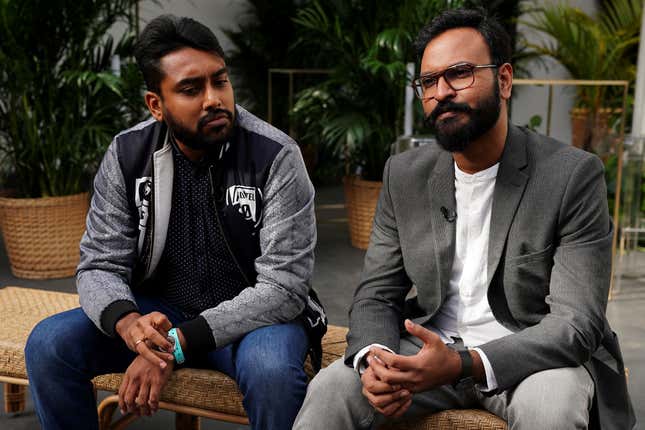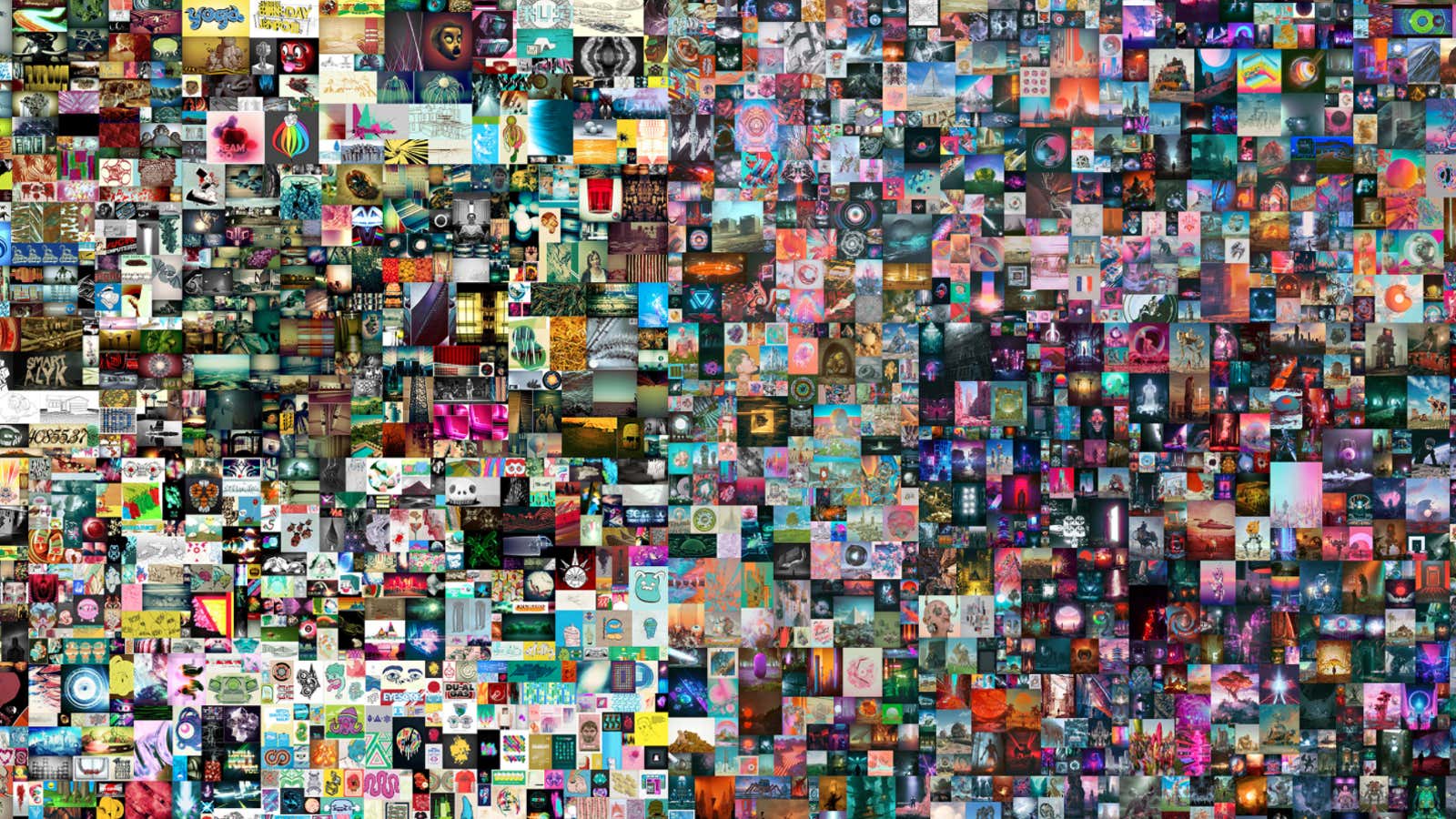Art Basel Miami is abuzz with crypto art. From immersive augmented-reality installations to “toy NFTs” in cereal boxes, the range of projects showcased at the contemporary art fair that opened on Dec. 2 offers a snapshot of the wild tangents the burgeoning field has taken in recent months.
Crypto art—essentially a digital asset with ownership guaranteed by a non-fungible token—became a topic of wide interest after Christie’s sold a jpeg for $70 million in March. The mind-boggling sale of Beeple‘s The First 5,000 Days has spurred countless other NFT gambits from artists of all caliber.
Vignesh Sundaresan (better known as MetaKovan) and Anand Venkateswaran (a.k.a Twobadour), the bitcoin investors who won the Christie’s auction, are particularly thrilled to see the genre flourish. Apart from the notoriety of owning the most expensive jpeg in history, the two investors from Tamil Nadu, India, have a bigger motive: to disrupt the Western-centric lens of the art world.
“Imagine an investor, a financier, a patron of the arts. Ten times out of nine, your palette is monochrome,” MetaKovan and Twobadour wrote in a joint blog post after the Christie’s auction. “The point was to show Indians and people of color that they too could be patrons, that crypto was an equalizing power between the West and the Rest, and that the global south was rising.”

The Singapore-based duo have since launched a $100,000 fellowship for writers and content creators interested in the field, along with an art festival dedicated to NFTs called “Dreamverse.” They’re also creating a virtual museum for crypto art—a “meta souk,” as they call it.
MetaKovan and Twobadour say they’re not curators but community-builders. In their view, good art is more about the process rather than the result, and patronage is about friendship instead of genius. Ultimately, the goal is to “break the cultural hegemony,” as MetaKovan puts it, and offer a space for any willing and eager creator regardless of pedigree or geography.
Could crypto really shake up the established order in the art world? Quartz spoke with MetaKovan and Twobadour at Dreamverse’s launch in New York City to learn more about their mission.
Quartz: How do you explain the boom in crypto art?
MetaKovan: Crypto needs art more than art needs crypto. NFTs and the technology behind it have existed for a while now; the only thing that’s changed is this influx of artists. They’ve legitimized this.
What excites me most is that when you see an artist here [in the Dreamverse exhibition]—you should ask them what they do with the money. Most of them, in my experience, will say they supported another artist.
Do you really feel there’s racism in the art world?
MetaKovan: I wouldn’t use such a strong word like racism. What we’re trying to express is the fact that we assign value to something based on our own lens. We definitely give a premium to some cultures and not others. If you’re an artist from one of those lesser-known cultures, there’s likely not going to be a market for your work.
For example, if I’m a poet in my own native language, which is Tamil, who’s going to buy it? Now, there’s a project here featuring Thiruvalluvar, the 5th century BC poet and philosopher. It’s a great application of AI by Althea that we ended up buying. Now he’s there for eternity and you can consult him for your daily life problems.
What we’re trying to is say is that we have to expand how we appreciate art beyond the European sensibilities.
Twobadour: I think [the literary critic] Walter Mignolo put it best when he said that if your culture or art can’t be described in one of six European languages, it’s not considered culture.
What do you say to the critics who say much of crypto art is actually bad—including several elements of the Beeple piece you bought.
MetaKovan: I really do humbly take all the criticism from buying the Beeple piece. As you know there’s been a lot of criticism over its content. But I think people’s skepticism is not just about what’s in Beeple’s piece, but about everything about NFTs.
So do you actually like Beeple’s “Everydays” piece? What kind of pleasure do you get from a piece that cost you $69 million?
Twobadour: What drew us to Beeple’s work was not just the art but the process and his almost spiritual level of consistency. One work of art for art’s sake, done without fail over the course of 13 years—good days, bad days—that’s very strong.
But how do you engage with it?
Twobadour: We want to share it. We are building a structure in the metaverse in a monumental scale, which hopefully can become a focal point for culture and performing arts. This will be the permanent address of the Beeple Everydays piece. It’s being designed by Joshua Ramus of Rex Architects, who also designed Perelman Performing Arts Center at the World Trade Center.
Twobadour, you describe yourself as a “truffle sniffer” for crypto art. How do you hone your nose?
Twobadour: My first experience with art has been the crypto space, so digital art. Of course most of us are exposed to art all our lives, but when you try to reach out [to institutions], you’re made to feel that it’s only for people with means, like it’s locked up in some ivory tower. Sometimes, you’re also made to feel like you’re not cultured enough. That has been my experience for 30 years of my life. When I did get into the NFT space, I suddenly found these profound, incredible relationships with over 100 artists over the course of eight months. That really changed my sense of self. It told me that I was finally worthy enough to engage with art and that has been a beautiful thing to me.
As far of as the curation or “truffle-sniffing,” it’s really about the emotional experience. Art doesn’t need curation, it just needs context. An artist-friend of ours described said that when he sees a work of art for the first time, he tries to understand how it makes him feel. I think that’s a beautiful thing. Ultimately you just need to go back to your gut—go with how the work moves you.
We’re currently in a world capital of art. Are you going to see any museums in New York while you’re here?
MetaKovan: I want to go to every one. I have a few friends in New York and Los Angeles [who know art] and I’m going to dedicate a day to go with them. They can be curators of that experience.
Twobadour: I’ve been to the Met, and it left me with a conflicted understanding about how it was created. I would love to get more context on art. I’m more interested in art history now than I ever was before because I got a taste in digital art.
But no, we don’t have time to visit any museums on this trip.
You’ve been active in the metaverse for a while. How do you feel about big corporations entering the space and suddenly sitting at the table?
MetaKovan: They’re not sitting at the same table but they think they are. The metaverse is about decentralization and they’re about central planning. There are going to be a lot of companies who see this as a trend and want to commercialize it but I think they don’t really understand what’s happening here.
People want change—an alternative to the current system. They’re questioning who owns the data and the platform, who makes all the money. For it to work, companies need to change their ways to be more user-powered in terms of ownership and governance. This is a very different shift in mindset. Companies who just take the name [metaverse] are about to find out that it’s not that simple.
